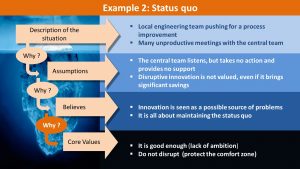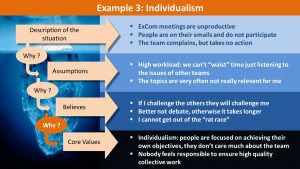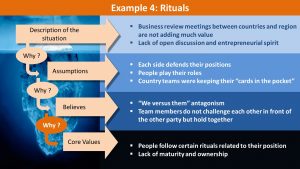Many of the issues we encounter in our organizations have deeper cultural root causes. Just fixing the visible part of the problem is not enough. We know this, but we rarely include a cultural diagnostic into our problem-solving approach. Instead, we end up addressing only the structural aspects of the issue. Consequently, the problem usually comes back quite soon. You will find here a simple and practical tool to assess cultural root causes as part of your problem solving. In addition, I have outline 4 concrete examples to illustrate how the approach works.
Why to include a cultural diagnostic into problem solving?
Many of the issues we encounter in our organizations have deeper cultural root causes. Just fixing the visible part of the problem is not enough. We need to go deeper into the root causes of the issue.
We know this, but we rarely include such a cultural diagnostic into our problem-solving approach. Instead, we are tempted to rush to quick fixes, and we end up addressing only the structural aspects of the issue. As a consequence, the problem usually comes back quite soon.
Why is this often not done?
As a matter of fact, we lack a practical tool to conduct this deeper root cause analysis in a simple and efficient way. Wouldn’t it be great to have something at hand that can be used in any circumstance and without a massive time commitment? This is precisely what you will find in this article!
The famous iceberg concept
But before we look into that, I would like to quickly remind you of a framework for company culture that many of you have certainly heard of before. It is the famous iceberg concept.
In the iceberg you have the part that is above the surface. That is the visible part. And that is typically related to the organization structure, to processes, systems and capabilities.

Below that there is the invisible part of the iceberg. This is the company culture, which has several levels. I use the A-B-C framework to describe the 3 levels that we usually differentiate concerning company culture (see also my article on the Unwritten Rules of the Game).
A level: Assumptions and attitudes
The first level below the surface – The A level – is related to and assumptions and attitudes. That is basically the perspective people take on things they can observe in the organization. With other words, it is their point of view on these events.

B level: Believes
Below that you have the B level. These are the believes. That is how people make meaning of the things they observe. It is how they come up with an interpretation and how they distinguish between what they believe to be true on not true.

C level: Core Values
At the lowest level you have the core values. These are the underlying core values that people have. These are usually influenced by our education as well as the religion and broader cultural environment that we have been bought up in. Those core values exist at the individual level, but there is also the collective part of these core values that are shared within the organization.

Get started for the interviews
The approach that I would like to outline works the following way: you should identify approximately 20 people who are involved in the situation where you encounter the problem. You should select people who are aware of that situation and who have an understanding of the issue. These 20 people should then be interviewed separately. One-hour interviews are usually sufficient.
Description of the problem
You will first ask them to outline the problem to you and to share their understanding of this issue. A way of asking that question could be: “Please outline a concrete situation where the issue that we need to resolve has occurred and make that description quite specific. Additional questions may be:
- What is the context in which this issue occurs?
- Who are the people involved?
- How could the issue be observed?
- What are the consequences of this problem for your organization?
You will then ask 3 “why” questions. This is the reason why I call this the 3-why-approach.

First “why” question
In the first “why” question you should ask your interview partners to outline why the problem is existing in the organization. You could formulate that question for example as follows:
- Why do we have this issue? What is causing it?
- Why do you believe that this situation occurred the way it did? What has triggered this?
- Why do people behave in a certain way, if that is not helpful for the organization?
Here you will usually reach the first level of cultural causes. It is important to capture the words people use, because in the second “why” question you will address those first level root causes.
Second “why” question
In that second “why” question you will ask why these fist level cultural causes actually exist in the organization. An here we usually move further down into the company culture and we reach the level of the believes. You could formulate this for example in the following way:
- Why do people operate in this dysfunctional way? What drives them to do so? What triggers these behaviors?
- Why is your organization struggling to overcome that problem? What contributes to stabilizing it as a pattern in the company?
Third “why” question
As you can now certainly guess, the third question is again a “why” question. You will ask the person to outline why the 2nd level causes exist in the organization. Here we should be able to touch on some of the core values that are the driver of everything people do in the company.
You may ask:
- Why can we not break free from the patters outline before?
- Why do people believe that they behave in the right way? Are there certain indirect benefits that could be perceived in some parts of the organization not to challenge the status quo?
So you see that with 3 very simple questions you can actually dig deep into the company culture. You don’t need to outline that A-B-C framework, but to your interview partners, but you will certainly have it in mind and it will guide you.
4 examples
You will see here 4 concrete examples that illustrate what findings you can obtain using the 3 why approach.




Bring the cultural root causes to peoples attention
The next step after having conducted the interviews is to summarize the interview outcomes and to share these findings with the team. That will allow you to put these cultural root causes on the table that people usually don’t see because they are under the surface.
The simple fact of bring these cultural root causes to the daylight allows people to become conscious of them and to start reflecting about these aspects. This will help them understand what the relation is between the deeper cultural root causes and the issues that the company is confronted to. That awareness of the team will in and of itself already contribute to the problem solving, because it might trigger behavioral changes that will be beneficial for the organization.
Connect your action plan to the cultural root causes
On top of that, you will of course define a more detailed action plan with specific corrective actions. And all these actions should be connected also to the deeper cultural issues that you have identified. You will be able to enrich the aspects of problem solution that are related to the visible part of the iceberg (structure, process, systems) to the more deeply rooted cultural dimensions that are related to that problem.
I hope that this will help you make your overall problem solution much more powerful and much more sustainable.
More information in my book:
Sven Sommerlatte : Successful Career Strategy – An HR Practitioner’s Guide to Reach Your Dream Job (Springer, June 2023). ISBN: 978-3-662-66790-3
